Things not to do when publishing a book on Xiangqi (or any other topic)
One minute version
If you're buying an English book on Xiangqi do not buy "A Beginners guide to Xiangqi" by Tyler Rea: It's a ripp-off and does more harm than good. For something in English, you could go with "Chinese Chess: An Introduction to China's Ancient Game of Strategy" by H. T. Lau for print or browse www.xqinenglish.com, instead.
Disclaimer
- First, sorry for the poor picture quality!
- If I highlighted say two errors in a picture below, it does not mean it's only two.
- This review is not meant to be complete: it's way too much already.
How did I get here?
I ran into this video on
YouTube: While I've been playing Xiangqi for quite a while already, I was
thinking "that book looks like fun, I'll buy it just to have a closer look,
maybe there's something in there that I haven't seen yet, too".
So I did
have some expectations. I started skip-reading through the book and soon
stumbled over error after error: to the point of laugh-or-cry. It starts with
the cover page, already. Read on for details.
Quick review summary
- Whole chapters match Internet content 1:1 (mostly xqinenglish.com, also en.wikipedia.org).
- About 100 pages are wasted to two uncommented example games, one move per page.
- Of those, the first example game is declared a win when the king is not even in check.
- Poor teaching (mis-leading, logic errors, no examples where needed)
- No chapter explaining AXF/WXF (or any) move notation (despite use in the book)
- Many errors details, spelling, case, punctuation (even on cover page)
The book lacks declaration of an edition or a print date. It does say "Printed in Germany by Amazon Distribution GmbH, Leipzig" at the end. According to the book's Amazon page it was published at/by CreateSpace: Self Publishing and Free Distribution for Books, CD, DVD, "an Amazon company" in 2013. This beginners guide is actually a beginner's guide. Maybe that's a typo.
The cover says it loud and clear
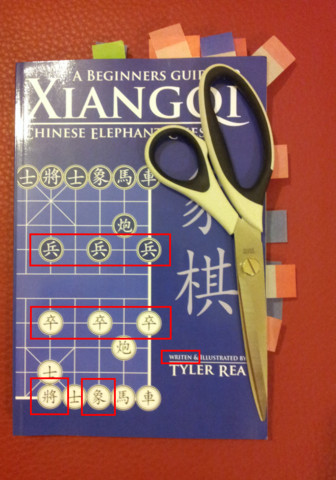
Interesting things to spot on the cover:
- "Writen" should have been "Written" with double "t"
- On the bottom, Red's king and elephant use the characters of Black
- Red's pawns show characters of Black's pawns and vice versa
Too bad I noticed all of that after buying.
Whole chapters match Internet content 1:1
So far I have identified these matches with Internet content (some 1:1, some adjusted):
- Page 8, look for "The pieces start in the position shown in", matches en.wikipedia.org: Xiangqi
- Pages 45 to 47, look for "Opening game:", matches xqinenglish.com: The Anatomy of Xiangqi Part 1
- Pages 48 to 51, look for "Characteristics of the mid game include", matches xqinenglish.com: The Anatomy of Xiangqi Part 3
- Page 52, look for "In Xiangqi, the end game", matches xqinenglish.com: The Anatomy of Xiangqi Part 4
- Pages 52 to 54, look for "Xiangqi composed games or endgame compositions", matches xqinenglish.com: Introduction to Xiangqi end game compositions
- Pages 170 to 186, look for "Glossary of Xiangqi terms, in English", matches xqinenglish.com: Glossary of Xiangqi terms
The author of xqinenglish.com confirmed to me via e-mail that use of his content in that book has not been authorized/licensed by him. The two places where I noticed copying first: At page 170 it reads "term use[d] on this site" rather than "in this book":
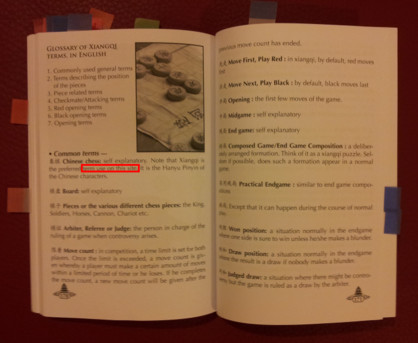
At page 49 the "Basic, commonly used tactics in Xiangqi" is not a complete sentence and does not have a full stop either. That is because in the original that is the title of a section, not a sentence.
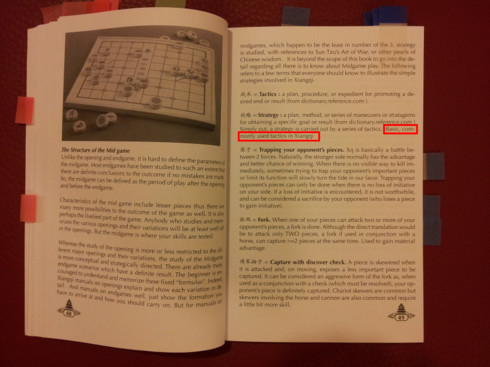
On the example games
While showing a complete game move by move could be helpful in teaching, a few things went wrong in general:
- Moves should be commented, e.g. "Red is attacking piece X to make up for blacks attack against .." rather than "Black has responded by advancing the horse".
- WXF/AXF and algebraic move notation could have been shown: There is plenty of space for that.
- Since there are no arrows indicating the current move on the board, "finding" the move is much more work than necessary, especially when turning pages.
- No more than a single move per page is plain waste of paper.
- Roughly 100 pages for two examples games take more than half the page count.
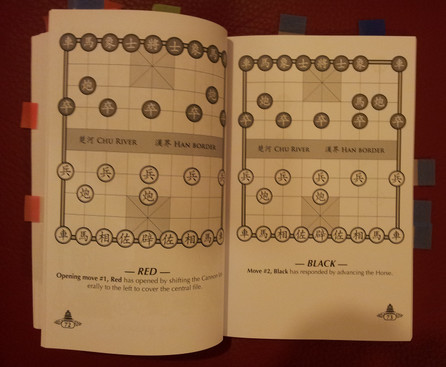
On the first game in particular: The game ends at move #79 of Red which is commented as:
WINNING Move #79, Red secures Checkmate. Black's General is it check from Red's Chariot and Red's General as part of a Face to face laughing check.
That's rather surprising since Black is not even in check after Red has moved. Is this a joke?
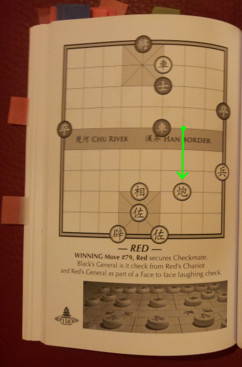
On
the second game: page 167 shows the second last move of the game. Black
responds with R9+2 / Ri0-i8. How does that do anything against the threat
of C5=6 / Ce5-d5 by Red? What about C2=5 / Cb8-e8 for a proper reply?
If we assume a really poor opponent, maybe that deserves mentioning. Also, let
me use the occasion to point out the characters used for Red's king and
advisors. A friend of mine who has been studying English, Chinese and German
literature on Xiangqi for years said he has never seen those characters used
anywhere in the context of Xiangqi.
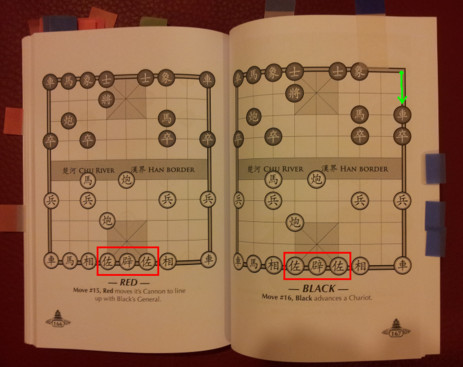
The quality of teaching
This page is meant to teach movement of the king:
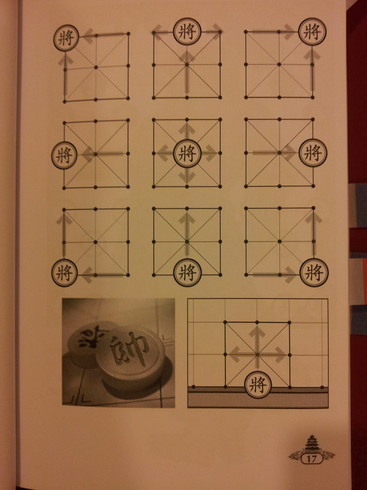
What I see is:
- Pictures indicating movement of more than one step at a time
- Lack of a system: it's neither where-to-go-from-here nor where-could-he-have-come-from
Up next is the oddity I noticed very first: How would the two pawns go sideways before crossing the river?
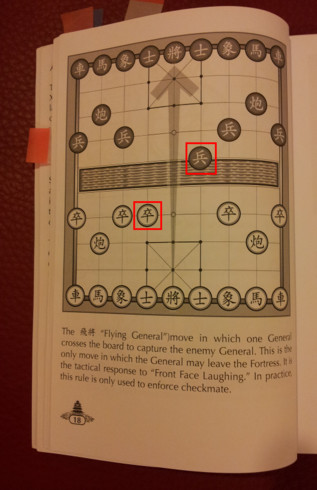
This page is meant to explain movement of the horse. With that little blocking pieces there are quite a few move options missing.
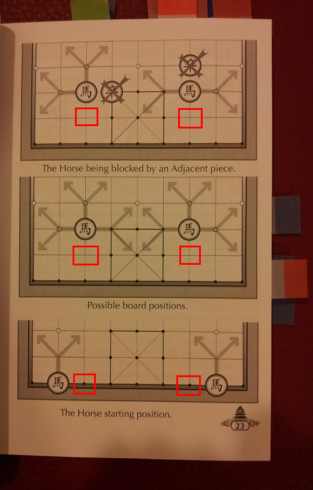
Here the idea seemed to be: show all possible steps a pawn can do. However, there are lots of arrows missing:
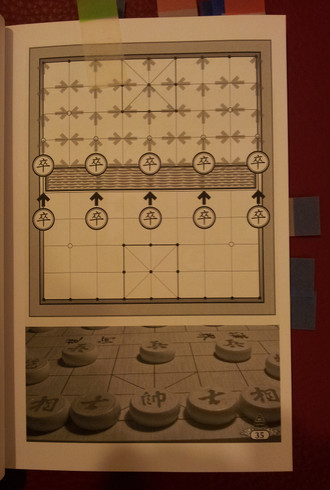
This one is really bad: If I hop my cannon right in front of the king with no protection, he eats my cannon and that's it:
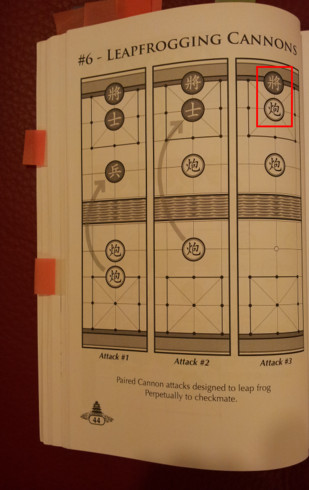
To me, this dry list of checkmates clearly lacks examples:
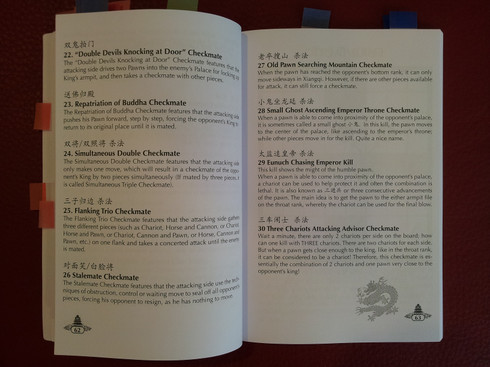
No chapter on move notation
Despite use of AXF notation in the book, there is no chapter explaining how to read or write that (or any) move notation. Why not?
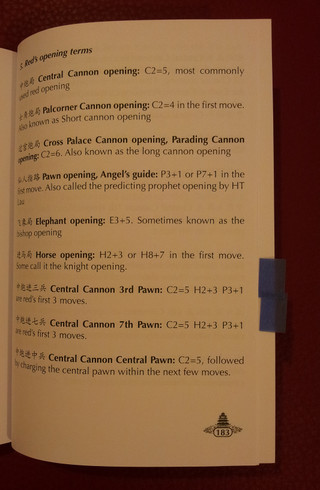
Many errors at details, spelling, case, punctuation
In a printed book, finding spelling mistakes is expected to be hard. Not so with this book: A few examples. On page 4 we can see how punctuation is pulled into quotes — always but once:
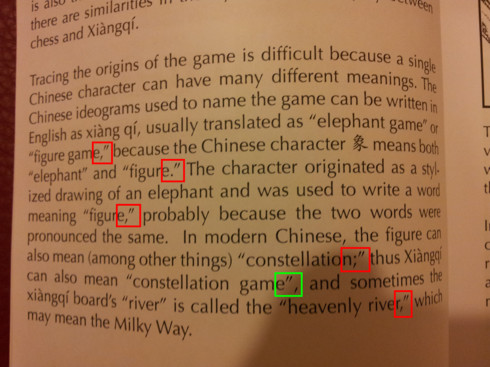
The word "Xiangqi" can be found in the book as "Xiàngqí", "Xiànqí" (typo, lacks "g") and "Xiangqi" (without accents):
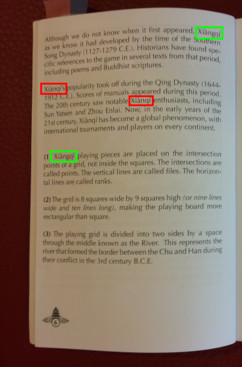
Also, uppercase is used at interesting places, e.g.
- Page 44: "leap frog Perpetually"
- Page 45: "The Anatomy and structure"
- Page 39: "to Augment your defense"
to name a few. That's all for the moment.
(Update 2014-08-31: The book is "out-of-order" on Amazon.com and .de; as of today, it is sold by a reseller for 32.05 EUR at Amazon.de and for 189.20(!) USD at Amazon.com.)